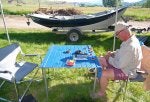Sparse, I'm going to take a crack at this complex question.
Only in recent years have I begun to use loop-to-loop leader connections in part because of this hang up in the guides potentiality when employing long leaders, which I always do.
For background, I have fished Orvis Braided Butt leaders since 1984 and Beartooth Braids before that. Sure I also build blood knotted variously tapered leaders for some freshwater and all saltwater applications out of both Nylon and Fluorocarbon (salt only) and eschew knotless, extruded commercial leaders as their turnover and control are below my dry fly standards. But lets stick with Braids and Furls. And lets address the line first. I am going to refer to a 5-weight floating line to exemplify this process.
Firstly and this applies to all leader types regardless of design or material, an uninterrupted transfer of energy is paramount from line to leader, no hinging is acceptable. One confirms this by employing the Parabolic Test.

The original Orvis Braids did not have a loop but came with a plastic pin inserted into the hollow core. One removed it and cutting the tip of the fly line (of course lines did not come with factory loops back then either) at an acute angel, inserted it 1/2 to 3/4" into the Braid. A good droplet of Zap-A-Gap slow setting, high viscosity cyanoacrylate adhesive was applied and tipped to evenly coat and penetrate the line/braid interface and set aside to fully cure, at least an hour. This formed a strong, smooth and unobtrusive line/leader connection. Even after Orvis started splicing loops into the Braids, I would sever them and employ this crafted connection. Then the line makers started including factory welded loops on both ends of their lines. Very clean and convenient but those in the know where aware they were merely a thermo-chemical bonding and about 75% the strength of the line itself. To preclude splitting or other forms of failure, I mechanically reinforce them with a 15 turn nail knot of 20# Fluoro over the doubled portion of the loop at both ends and loop the line to a Bimini in my backing. I started looping on the Braided Butt experimentally and it proved quite acceptable with no problem entering the guides when netting a fish. Similarly, I have begun using some Cutthroat all Nylon Furls (I find thread based Furls to collapse badly especially when wet, which of course, they have to be) which I like particularly on my 6-weight and have no issues with their loop-to-loop interface either. I do not loop on a tippet to either their loop or worse, tippet ring, but nail knot on a 1' section of 0X and blood knot down in .002 or .003 short section increments to my 5' long tippet as I do with the Braid.

It is important that I note that Orvis mislabels their Braids and has since day-one decades ago. A size Medium, described as matching #'s 6 and 7 lines matches best with #'s 4 - 6. The thinner one intended for #'s 4 and 5 lines hinges unacceptably. This is by far my favorite Orvis product and don't think I have not tried to discuss this with them at the highest levels...with no impact.
If one has a line with no loop or the loop has failed, a new one is easily formed by doubling the tip and tying a multi-turn nail knot over it and closely trim the tag of tip. This is superior to attaching a braided loop connector as these are prone to creating a hinge. Upgrade this formation by lightly coating it with a UV curing, low viscosity sealant like Clear Goo using its high intensity UV flashlight.
The more complex question is affixing a solid Nylon Furl to a fly line and not using loops. I have never done this but you have inspired me to imagine how I would attempt it. I can think of no acceptable way of lashing, tying or bonding the Furl's butt directly to the lines tip. Therefore I propose this experiment: Nail knot to the tip of the fly line a hank of monofilament butt material, for our 5-weight, typically about .021". Then confirm it is the appropriate diameter via the Parabolic Test. Then, keeping this monofilament length as short as practical, nail knot it to the butt of the Nylon Furl. I would apply a thin coat of Clear Goo or cyanoacrylate to both, especially the multi-turn nail knot to the Furl which we do not want to unravel. So, we would have something like a 6" interface of .021 mono connecting the fly line tip to the Furl butt with, hopefully, no hinging nor protruding bulk to hang up in tip-top or small upper snake guides. Sure some leader craft is involved in this proposal but its cold outside and this should be performed indoors under a bright light.




